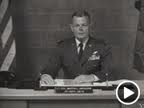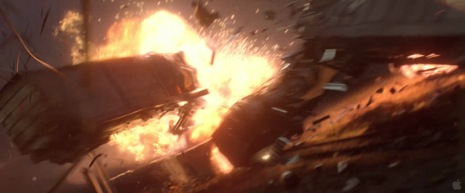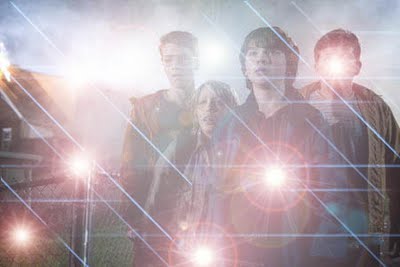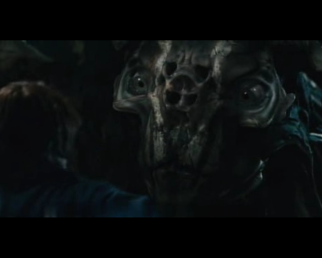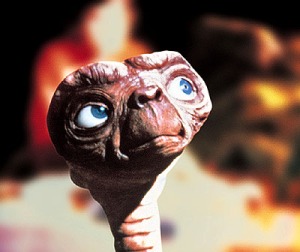We’ve all heard by now about how J.J. Abrams’ Super 8 is a big special effects movie that’s grossly indebted to and reverent of the SFX movies of Steven Spielberg. But why exactly? Answer: The film’s subtext is a subtly coded defense of the storytelling power of modern digital special effects characters. Here’s my evidence.
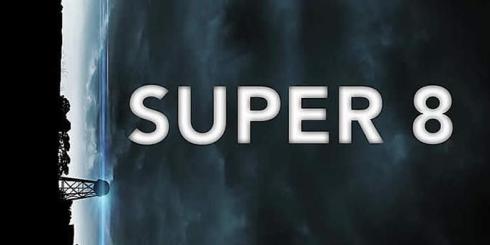 1. “Super 8” = “superate” which means to outdo, to surpass, to exceed. This movie’s subtext is about how digital FX surpasses (but also harkens back to) photographic/analog FX.
1. “Super 8” = “superate” which means to outdo, to surpass, to exceed. This movie’s subtext is about how digital FX surpasses (but also harkens back to) photographic/analog FX.
2. The Super 8 alien is captured, revealed to non-believers, and made real to the characters in the movie (and to the audience) by traditional filmmaking techniques, i.e. the government’s secret black & white footage and the DIY zombie film being made by Charles and the other kids at the train station.
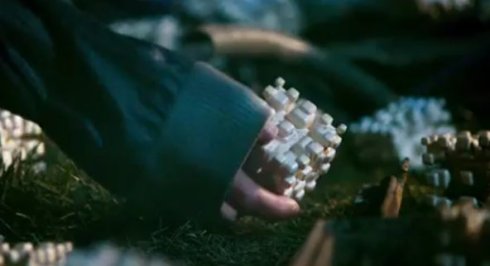 3. The alien’s technology consists of interchangeable discrete little almost-digital units that can be assembled and reassembled with ease to suit the alien’s needs. Metaphorically, these are very like the digital blocks that filmmakers wrangle into movie characters to suit their storytelling needs.
3. The alien’s technology consists of interchangeable discrete little almost-digital units that can be assembled and reassembled with ease to suit the alien’s needs. Metaphorically, these are very like the digital blocks that filmmakers wrangle into movie characters to suit their storytelling needs.
4. The alien’s release at the site of a train wreck represents in metaphor the collision between very old film technique and very new. Way back in the 1890s, films by Thomas Edison and the Lumiere Brothers famously shocked and awed audiences with the very close passings of huge trains at train stations. The kids in Super 8 set an important scene at the fictional Lillian, Ohio’s fictional train station and in doing so capture footage of the digitally rendered and digitally technologically advanced space alien. [I probably won’t go into detail here about how ingrained the “train = filmstrip” metaphor is in film history and in critical thought.]
5. The lens flares the lens flares the lens flares. Sadly, the internet has made more or less a joke out of the lens flares in Super 8. But that’s just kind of stupid and lazy. When a filmmaker makes totally 100% sure that even the most moronic audiences notice some non-plot thing in his film, there’s almost always a solid reason for it. Yes, Super 8‘s lens flares are a constant tribute to a very noticeable stylistic element of Steven Spielberg’s films.
But in Super 8, the lens flares are also a constant reminder of a naturally occurring, photographic, in-camera filmmaking technique—an effect, if you will. Some of J.J. Abrams’ lens flares are real and some were made digitally, apparently, so they serve metaphorically as a link between FX filmmaking’s past and its present/future. At the end of Super 8, the alien’s digitally made ship disappears in a clever, knowing lens flare that’s really one huge, giant nod at Spielbergian FX films of the past, especially E.T. It’s almost like the digitally sophisticated SFX alien is waving farewell to beloved analog FX of old, with a kindly wink of lens flare. To take it a bit further, E.T.’s ship’s departure at the end of E.T. results in an arcing rainbow, one of nature’s own special effects, a trick of real light that sends E.T. home and itself refers back to another home-concerned and rainbow-obsessed FX movie: The Wizard of Oz.
6. And this one’s a bit of a stretch: In the story, all the Super 8 alien has to do to gain a human being’s sympathy and understanding of its plight is to touch that human being. Basically, once it touches you, you no longer fear it, it becomes relatable to you. Metaphorically, a digital FX creature must only make a successful emotional appeal in order to perform the necessary storytelling function, just the way old FX creatures used to. Hence the size and eventual dampness of the Super 8 alien’s window-to-soul eyeballs, which you can only sort of see in the image above. At a key point in the film, the alien’s insectoid eyes soften; they become sentient and emotional, almost anime-level sympathy generators. Or E.T.-level sympathy generators, if you prefer.
There are more subtle bits to this I can’t remember right now, but a lot of the movie’s detail builds toward this allegory. I think that might be why a lot of viewers found the whole thing fairly hokey—Super 8 revives a lot of beloved but hoary tropes in service of a statement about digital FX that it didn’t want to just come all the way out and say. It preferred to be very, very entertaining instead, and slip its “big meaning” right by you. For me, it will be very interesting to see Super 8 again, seeing it the way I do now. And I’ll probably add more to this post once I’ve re-seen it.
You know what the comments are for, so fire away.
